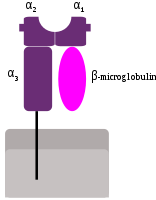
Photo from wikipedia
Major histocompatibility complex (MHC) genes code for key proteins of the adaptive immune system, which present antigens from intra-cellular (MHC class I) and extra-cellular (MHC class II) pathogens. Because of… Click to show full abstract
Major histocompatibility complex (MHC) genes code for key proteins of the adaptive immune system, which present antigens from intra-cellular (MHC class I) and extra-cellular (MHC class II) pathogens. Because of their unprecedented diversity, MHC genes have long been an object of scientific interest, but due to methodological difficulties in genotyping of duplicated loci, our knowledge on the evolution of the MHC across different vertebrate lineages is still limited. Here, we compared the evolution of MHC class I and class II genes in three sister clades of common passerine birds, finches (Fringillinae and Carduelinae) and buntings (Emberizidae) using a uniform methodological (genotyping and data processing) approach and uniform sample sizes. Our analyses revealed contrasting evolutionary trajectories of the two MHC classes. We found a stronger signature of pervasive positive selection and higher allele diversity (allele numbers) at the MHC class I than class II. In contrast, MHC class II genes showed greater allele divergence (in terms of nucleotide diversity) and a much stronger recombination (gene conversion) signal. Gene copy numbers at both MHC class I and class II evolved via fluctuating selection and drift (Brownian Motion evolution), but the evolutionary rate was higher at class I. Our study constitutes one of few existing examples, where evolution of MHC class I and class II genes was directly compared using a multi-species approach. We recommend that re-focusing MHC research from single-species and single-class approaches towards multi-species analyses of both MHC classes can substantially increase our understanding MHC evolution in a broad phylogenetic context.
Journal Title: Heredity
Year Published: 2021
Link to full text (if available)
Share on Social Media: Sign Up to like & get
recommendations!